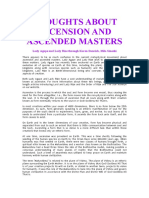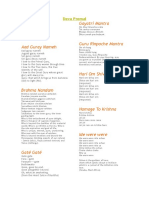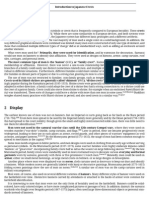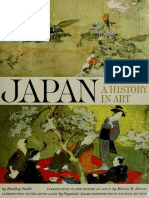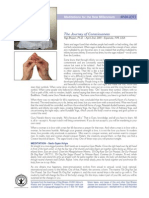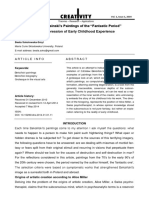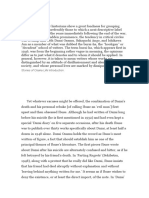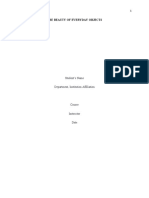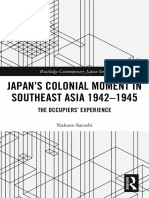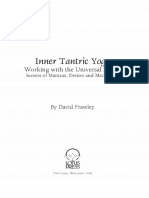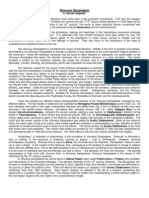Professional Documents
Culture Documents
Iki Ningyo Living Dolls PDF
Uploaded by
Nicte Ha Alpuche0 ratings0% found this document useful (0 votes)
253 views11 pagesThis summary provides the key details from the document in 3 sentences:
The document discusses Matsumoto Kisaburo, a 19th century Japanese artist famous for creating incredibly lifelike "living dolls" or iki ningyo. It describes how in 1868, Kisaburo created a masterpiece depicting the Buddhist deity Kannon as a traveling woman for a large exhibition in Tokyo. This piece was so perfect that he donated it to a temple, where it remains on display today and is still venerated. The exhibition helped establish Kisaburo as one of the premier artists of iki ningyo and a leader in the misemono exhibitions commonly held at Japanese temples.
Original Description:
Original Title
iki ningyo living dolls.pdf
Copyright
© © All Rights Reserved
Available Formats
PDF, TXT or read online from Scribd
Share this document
Did you find this document useful?
Is this content inappropriate?
Report this DocumentThis summary provides the key details from the document in 3 sentences:
The document discusses Matsumoto Kisaburo, a 19th century Japanese artist famous for creating incredibly lifelike "living dolls" or iki ningyo. It describes how in 1868, Kisaburo created a masterpiece depicting the Buddhist deity Kannon as a traveling woman for a large exhibition in Tokyo. This piece was so perfect that he donated it to a temple, where it remains on display today and is still venerated. The exhibition helped establish Kisaburo as one of the premier artists of iki ningyo and a leader in the misemono exhibitions commonly held at Japanese temples.
Copyright:
© All Rights Reserved
Available Formats
Download as PDF, TXT or read online from Scribd
0 ratings0% found this document useful (0 votes)
253 views11 pagesIki Ningyo Living Dolls PDF
Uploaded by
Nicte Ha AlpucheThis summary provides the key details from the document in 3 sentences:
The document discusses Matsumoto Kisaburo, a 19th century Japanese artist famous for creating incredibly lifelike "living dolls" or iki ningyo. It describes how in 1868, Kisaburo created a masterpiece depicting the Buddhist deity Kannon as a traveling woman for a large exhibition in Tokyo. This piece was so perfect that he donated it to a temple, where it remains on display today and is still venerated. The exhibition helped establish Kisaburo as one of the premier artists of iki ningyo and a leader in the misemono exhibitions commonly held at Japanese temples.
Copyright:
© All Rights Reserved
Available Formats
Download as PDF, TXT or read online from Scribd
You are on page 1of 11
Art in Focus
I KI NI NGYO: LIVING DOLLS AND THE LEGACY OF
MATSUMOTO KISABURO
By Alan Pate
In 1868, in preparation for a large-scale exhibit of iki ningyo (living dolls)* to be held at the Asakusa Sensoji
Temple in the newly christened capital of Tokyo, Matsumoto Kisaburo (1826-1892) created his most enduring
masterpiece: a life-sized image of Kannon dressed as a female traveler. The exhibit itself, designed as a series
of vignettes involving over 33 individual figures, was a tour de force and represented Kisaburo at the peak of
his powers as a ningyo artist. It was based on popular stories of faith and manifestations of the power of the
Buddhist deity Kannon, called the Saikoku sanjusan [Miraculous Deeds of Kannon at the 33 places of
Shikoku]. This particular image, the tanikumi kannon, clothed in rich silken robes and wearing the lacquered
cap of a traveling noblewoman, was suffused with a life and vitality that gave these striking figures their name:
iki-ningyo or "living" dolls. The graceful pose of the body with the head looking back slightly over her left
shoulder, her finely formed hand, ripe and fairly pulsing with life, the index finger pointing delicately into the
distance, her enigmatic expression, beatific and haunting, was all masterfully rendered. Her ivory teeth and
inset glass eyes, exquisitely executed, completed the image of divinity. Such was the perfection of this
particular figure when Kisaburo finished it that, rather than including it in the intended exhibit, he donated the
piece to Jo koku-ji Temple in his home town of Kumamoto where it remains to this day as an object of
veneration. A second piece was subsequently created for inclusion in the Kannon exhibit which first appeared
in 1871.
*
The term iki ningyo did not come into common parlance until the early years of the Meiji Period (1868-
1912), but this term will be used throughout to refer to the roughly life-sized, non-mechanical ningyo forms
first documented in the early years of the Edo Period (1603-1868) and whose production continued well into
the early 20
th
century.
The Saikoku sanjusan opened in 1871 in the Ookuyama of Sensoji Asakusa in Tokyo and was repeated until
1878. The Tanikumi Kannon, representing the final stop on the pilgrimage route, relates a story in which Okura
Taro Nobumitsu, a gold merchant and devout follower of the Kannon, had a sculpture commissioned of an 11-
headed Kannon which he decided to carry to Kyoto to dedicate it to temple there. As he was carrying the statue
it grew inexplicably heavier and heavier. Fatigued he set the shrine down and from out of the shrine
miraculously emerged Kannon herself. Amazed and stunned, Nobumitsu followed the Kannon as she led him
for 5 li until she reached a place called Tanikumiyama. Standing there, from out of her lotus dias emerged a
fount of oil which Nobimitus used to create an everlasting lamp. He decided to build a temple there, in her
honor and in recognition of the miracle he just witnessed.
In addition to the Tanikumi Kannon, the exhibit contained 8 other images of Kannon in various guises.
Accounts from the period indicate that people were so struck by the beauty and realism of Kisaburos figures
that in addition to paying the entry fee to view the exhibit, they cast offerings at the feet of the various Kannon
in hopes of gaining merit and as a way of venerating this spectacular manifestation of Kannon in their midst.
Misemono
Kisaburos Saikoku sanjusan was just one of the many misemono (exhibitions) held at Asakusa Temple during
the 19
th
century. Misemono were temporary exhibitions or performances frequently associated with temple fairs
called kaicho. Held at various times of the year at Asakusa and other temples across Japan, kaicho were
originally an occasion when a particular, rarely viewed Buddhist relic or image from the local temple, or,
occasionally, one brought in from a distant temple, would be displayed for the public. Seeing and venerating
such an object was felt to bring great merit to the viewer, and the donations which poured forth during these
occasions from the visiting masses dramatically swelled the temples coffers as well. As they developed over
the years, more and more external forms of entertainment were gradually attached and the kaicho became
much-anticipated social events as well, attracting visitors from far and wide. Initially kaicho were held only
infrequently, but due to the great profits earned by the temples and the strong economic benefits felt by the
surrounding community, which provided food, lodging, and other services, kaicho became more and more
frequent. This was especially true for Asakusa Sensoji and Eikoin at the Ryogoku Bridge, also in Tokyo. Here
temporary booths, impromptu displays of legerdemain, physical oddities, animal acts, and special crafts were
permitted and encouraged by the temple authorities who allowed artists, jugglers, bards, and nearly every
imaginable form of entrepreneur to stage performances and exhibitions for the viewing public in exchange for
donations or, in the case of more elaborate exhibits like Kisaburos, for a small entry fee. Cool monster truck
games, monster truck games on flashracingonline.
Although these displays of popular entertainment had existed for centuries, the misemono of the late Edo
(1603-1868) and early Meiji periods, benefiting from relative long-term stability and economic prosperity of
the country as a whole, had developed into quite elaborate displays of technology and craft. The presentation of
saiku(fancy craftsmanship) to temples had long been a way of gaining merit. But over the years, the tradition of
donating relatively small-scale saiku gradually expanded from donation to display. Ultimately these displays
took on very dramatic forms and were at times presented in what Markus refers to in his work on Japanese
misemono as being on a "meglomaniacal scale," becoming significant attractions in an of themselves and in
some ways competing with the kaichos supposed main focus of attention, the religious images and relics. Saito
Geshin(1804-1878), the 19
th
century chronicler of Edo life, personally enjoyed attending the various misemono.
From his recollections and observances recorded in his Buko Nenpyo we can gain an idea of the immense
variety of things presented to entertain and tantalize the Edo populace: in 1776 a giant toad of velvet; in 1798 a
159 foot tall rendition of the Viarocana Buddha constructed out of basket material; 1815 a 22 foot tall
embroidered of the god Daikoku. Materials varied greatly: a giant Dutch ship composed entirely of glass,
complete with sails, scurrying figures on the deck was displayed in 1847, in 1853 the paragons of filial piety
crafted out of dried kelp(konbu) were displayed, and images crafted from whale whiskers by Takeda
Yoshisaburo in 1852.
The moneymaking opportunities present in these misemono attracted individuals and aspiring artists from not
only the immediate Edo area but far beyond. In addition, impresarios recruited particularly promising artists
from around the country, helped in advertised their upcoming exhibits through the commissioning of
advertising prints called hikihuda, and shared in the profits, which could be quite substantial. Kisaburo himself,
under the stewardship Shinmon Tatsugoro, a celebrated fireman turned promoter who held a virtual monopoly
on misemono held within the temple precincts of Asakusa Sensoji had risen from being an obscure ningyo artist
in Osaka to a place of prominence within the world of misemono. His exhibits of highly imaginative and
expertly rendered iki ningyo from 1854 to 1875 brought repeated praise. Some of his exhibits went on to tour
the country with return engagements in Edo, some enduring for 10 years or more, virtually unheard of in the
jaded culture of Edo misemono.
Kumamoto
According to family documents originally held by Kisaburos descendant Serikawa Saburo and reviewed by
Kuboto Beisho in his work Ningyo-shi, [Tokyo, 1937], Matsumoto Kisaburo was born on February 15, Bunsei
8(1826) to an oil salesman named Matsumoto Hambei living in the Ideguchi area of Kumamoto, Hijo
Prefecture. Early in life he showed great promise in carving and was apprenticed to a local scabbard maker. His
talent and rapid progress soon earned Kisaburo the enmity of his fellow apprentices and abuse at their hands
eventually forced him to return home where he crafted lanterns and paper stencils for textile dyeing. At this
point he also began to turn his artistic focus on the creation of dedicatory figures called hono ningyo. A local
festival tradition venerating the Buddhist bodhisattva Jizo(Kitshigharba) involved the creation of these hono
ningyo which were carved and displayed in each neighborhood before being presented to the temple.
Competition between the various neighborhoods was quite lively and Kisaburo along with another young artist
by the name of Yasumoto Kamehachi soon distinguished himself as a superior artist, each reportedly
challenging the other in the creation of increasingly sophisticated forms of ningyo.
The first recorded ningyo display by Kisaburo which may be classified as iki ningyo was executed sometime in
the early 1840s and was of a well-known scene drawn from history involving Akechi Mitsuharu(d.1582)
crossing the Lake Biwa narrows on his horse, Okage, near the Karasaki Pine. To set the scene, Kisaburo chose
to stage this particular tableau on the shores of the Shirakawa River which ran next to the Jizo Temple where
there grew a large pine tree. This hono ningyo display drew particularly high praise and further inspired
Kisaburo to focus on his growing skills as a ningyo-shi(ningyo artist). Importantly, this also illustrated a
growing sense of theatricality in his creations and methods of display. A second noted tableau done sometime
thereafter was placed in the gardens of the Hosokawa daimyo family where Kisaburo crafted a hono ningyo
that amazed the local populace due to its high sense of realism in which everyone could easily identify the
young maid from the Hosokawa household who he used as the model.
Osaka
Kisaburo married a local girl by the name of Machi and seemed to settle into a simple life in Kumamoto. But
the death of their daughter at a very young age followed almost immediately by the destruction during a heavy
rainstorm of an elaborate iki ningyo tableau featuring Kato Kiyomasa(1562-1611), for the gogatsu( Boys Day)
celebration, led Kisaburo to think of leaving the Kumamoto area for the city of Osaka. Reportedly obstructed in
his intentions by his in-laws, he eventually divorced Machi and moved to Osaka on his own at the age of 26 in
Kaei 2(1850). With little money of his own, he is said to have borrowed a silver coin from an inn clerk in
Osaka and purchased wire and silk crepe fabric(chirimen), setting out making hair ornaments which he sold to
a local haberdashery. His pieces were well received and he soon had sufficient income to bring his parents from
Kumamoto to stay with him. On a trip with his father, a devout Buddhist, to Hoganji(head of the Jodo Sect)
Kisaburo presented a group of artificial flowers which he had created as an offering to the temple. These
evidently drew the attention of the abbot who soon began ordering flowers from Kisaburo. From these small
starts and the quick recognition his skills received, Kisaburo was soon able to save up enough to purchase the
required materials and developed the confidence in his abilities to return to what was to become his lifes
passion, iki ningyo.
In Ansei 1(1854), Kisaburo staged his first ningyo misemono in Osaka. By this time he had again married, this
time to an older woman by the name of Ohide who was the daughter of the next-door neighbor. She is reported
to have frequently served as a model for his works, and while we do not have specific details concerning the
Osaka exhibit it is assumed that it was of Ohide, possibly portraying a courtesan. The exhibit was evidently a
great success, prompting Kisaburo to think of exhibiting in Asakusa Okuyama, the epicenter of 19
th
century
ningyo misemono. He petitioned the above-mentioned promoter, Shinmon Tatsugoro, sending along a small
ningyo as a sample of his work. Tatsugoro was greatly impressed and showed the piece to other ningyo-shi in
the Asakusa area to gain their approval for Kisaburos inclusion in the next scheduled kaicho. They were
initially quite skeptical that any provincial artist from Kumamoto could have much to contribute to the various
ningyo misemono displayed at Asakusa, which at this point had developed quite a reputation and following,
featuring such renowned karakuri ningyo(mechanical doll) artists as Takeda Kamekichi and Takeda
Nuidonosuke of the illustrious Takeda family from Osaka. But, reportedly, upon seeing the extraordinary
quality of the small sample ningyo, Kisaburos ingenious use of silk crepe to create moveable arms(an
invention attributed to Kisaburo), and the extremely skilful rendering of the face, the other artists were quick to
recognize his talent and give their ascent for his participation.
Edo
Kisaburos first Edo exhibit opened in the Okuyama on February 28, Ansei 2(1855) as part of an 80- day
kaicho being held at Asakusa Sensoji honoring an image of Kannon[Gesshin, p.143]. Kisaburos work was one
of three principal exhibits featuring ningyo. Takeda Kamehachis exhibit was set up in an enormous tent in
which he displayed a giant elephant 14-15 ken high on top of which rested a large pavilion in which dancers
moved about. A hikihuda exists from the period and shows an enormous white elephant lying down with its
trunk curved back along its body. Young children dressed in Chinese style with exotic hats and trousers are
shown dancing in an elaborate pavilion atop the arching back of the huge beast. Takeda Nuidonosuke presented
a very popular exhibit depicting the actor Ichikawa Danjuro VIII(1829-1854) whose recent suicide in Osaka
had created quite a sensation. The exhibit showed scenes of the kabuki theater including actors in make up,
scenes from behind the stage, with the culmination being Danjuro himself and his imagined trip to heaven
following his suicide to become a Buddha. Kisaburos exhibit included a famous beauty from the Maruyama
entertainment area of Nagasaki emerging from her bath and also featured grotesque figures from foreign lands
drawn from literary classic Sangakyo including: men with no stomachs, men with long arms(tenga) and men
with long legs(ashinga), exotic figures form Cochin China, among other novelties. And while none of these
figures remain, hikihuda of this particular exhibit dating from the period show an exotic scene featuring two
men carrying a third figure on a pole which passes through the hole in his stomach, tenga grabbing fish from a
river, all set against an exotic landscape.
Contemporary accounts describing all three exist. And while the great size of the elephant exhibit and the
scintillating nature of the Danjuro exhibit created much talk, the general reaction seems to be an overall
recognition of the superiority of Kisaburos figures. The celebrated bronze sculptor Takamura Koun(1852-
1934) was said to have seen these figures as a young man and reported that the doll makers of Edo were
stunned by the true-to-life impression given by Kisaburos creations. He recounts:
[a figure of a] geisha from the Maruyama area was seen naked in a bathhouse setting. Behind her was a
young servant girl holding a kind of washcloth. The geisha appeared to be about to enter the water, with a towel
just barely covering her private parts. Two more figures had just come out of the water and were arranging their
hair and putting makeup on in front of a mirror. The exhibit was very enchanting; the figures of this display
were especially highly praised.[Cited Nishiyama, Edo Culture, p.235]
Gesshin as well was on hand to see this particular display and recorded the following:
"living figures" from Osaka were put on display at Asakusa Okuyama. These figures were manufactured by
Matusmoto Kisaburo from Bingo(sic) in Kumamoto; they are said to be made, not of wood or clay, but rather
of paper mache. Many figures were exhibited: inhabitants of the island of long arms, the island of long legs, the
land of perforated chests, the land of no stomachs, and other figures from exotic lands. Figures and courtesans
from the Maruyama area[of Nagasaki] were also displayed. All of these figures, both men and women, are
completely lifelike. [Gesshin, Buko Nenpyo, vol. 2, pp.143-144]
Another period observer, Komiuchi Nanryo in his Edo Kenbun records:
Outside the tent[containing the elephant exhibit] was a large signboard showing foreigners playing paper-rock-
scissors. Inside were dolls depicting beings with no chest, with long arms, long legs, foreigners from Cochin
and of a beauty from Maruyama in Nagasaki. Looking at the color of the skin, the nails, they all looked so alive
that people called them "iki ningyo." [Cited Beisho]
Miyakwa Seiun in his Hoshoan Zuehitsu stated:
a year before I saw a show called "iki ningyo" at the Asakusa Okuyama. because of its reputation those who
did not see it would have been ashamed. people gathered in hoards and it was altogether an unusual happening.
The artist is rumored to be a very filial person, simple and pure in nature. His skills in rendering these ningyo
so naturally was such that it is said that his iki ningyo of a figure carrying firewood opened its mouth to
exclaim: "this is so heavy!" I also saw these figures and were very impressed."[Cited Beisho]
Part of the beauty of Kisaburos pieces was the intense attention to detail that he exercised on his creations,
adding discrete elements to the piece to heighten its authenticity, even in places that were not to be seen by the
viewing audience. Seiun goes on to recount how an individual he knew actually had the opportunity to observe
Kisaburo at his work. With that particular piece Kisaburo was adding a tattoo on a portion of the body that
would ultimately be completely covered by textiles. The following exchange is recorded:
When [Kisaburo] was criticized for taking his perfectionism too far, he replied that it was the same as fully
rendering a face of a figure even if it was to be wearing an amigasa [a Buddhist straw hat that hides the face
completely]. I was so impressed with what I saw that I myself would not have been surprised if the dolls started
speaking.[Beisho]
Iki Ningyo
By Kisaburos time, iki ningyo themselves had had a long history of development, though tradition claims that
it was the popular reaction to Kisaburos particular brand of hyper-realism that fist elicited the term "iki" or
"living" ningyo to be applied to the form. Hidari Jingoro(active1596-1644), a temple carpenter(miyashi) by
trade who also crafted life-sized ningyo on the side, is probably the earliest documented carver of what were
later to be termed iki ningyo. His 7
th
generation descendent, Hidari Matsumasa (active 1704-1716) took the
craft a step further, abandoning the miyashi trade of his family, setting up a shop in Kyoto near Imadegawa,
and focusing solely on these forms.[Beisho, 1937] Exactly who his clients were and what specific forms of
ningyo were produced is difficult to determine. But perhaps it was such works of the Hidari family that Ihara
Saikaku(1641-1693) had in mind in his novel "Life of an Amorous Man[Koshoku nidai otoko] when the
protagonist, Yonosuke, unveils, to the delight of a group of Nagasaki Courtesans, a group of 44 life-sized
ningyo brought down from Kyoto displaying the likenesses of famous courtesans in Kyoto, Osaka, and
Edo.(p.228). In the novel, the figures create such an impact that they go on to be displayed in the town of
Nagasaki where it became a popular exhibit.
One of the difficulties in tracing the development of iki ningyo as distinct from other forms of ningyo is the
paucity of historical records. Few early studies seem to have been undertaken with specific regard to ningyo
which would enable us to verify the development of specific ningyo forms, their overall construction, and use.
The development of ningyo, that is the use of human-shaped figures in various ritual and play contexts, can be
said to date from some of the earliest periods in recorded Japanese history. In the Jomon Period(1
st
millennium
BC), small human-shaped figures fashioned of clay with raised designs, usually female, called dogu have been
found in relatively significant numbers and are believed to have been employed in rites associated with fertility.
Later in the period we find the widespread use of larger figures called haniwa(lit. "circle of clay"), which were
much more sophisticated in execution, representing various figures male and female, some elaborately
decorated with designs implying jewelry, swords, armature, etc. Haniwa are closely associated with funerary
activities and are believed to have been buried along with the deceased to provide support and companionship
in the afterlife, thereby representing a certain level of wealth and status within the community.
The first documentary evidence of ningyo use in ceremonial contexts dates from the Heian Period(794-1185)
and reveal the wide spread practice of using flat, board-like figures in roughly human form called hitogata or
alternatively katashiro. These early ningyo figures were crafted of wood or iron approximately 1 shaku high
and 1 shaku wide and sometimes covered in gold or silver leaf, wrapped in textiles and placed directly in
coffins during funeral services. Documents such as the Engishiki published in the Engi Era(901-922) listing
court ceremonies and audience regulations show hitogata were ordered from the Mokoryo[Department of Wood
Carving] or alternatively from the Uchikuraryo [Department of Finance for the Imperial Palace][Kitamura,
1967]. All of these forms appear to be the direct descendants of the early haniwa forms and would have been
created by unknown artisans employed by the various bureaus and departments involved. Literary sources from
the period including Murasaki Shikibus Genji Monagatari, Sei Shonagon in her Pillow Book, make frequent
mention of hihina or "small, lovely things" and hina asobi or "display of hina" and indicate a lively ningyo
culture within domestic circles at court as well.
The earliest recorded, specifically named ningyo maker appears in the Shokusho tekagami [Great Mirror of
Craftsmen and Merchants] dating from the Meio Era(1492-1501) during the Muromachi Period(1392-1568)
which lists a Shioyaki Kajiko under the category of ningyo tsukuri(ningyo maker).[Tekiho, 1956] The
"kajiko/ku" ending to his name seems to imply a metal smith and from this one can reasonably deduce that he
crafted hitogata.
During the Edo Period, documents associated with ningyo and their craftsmen become much more frequent. In
the Jinrinkinmo zui[Moral Pictures for Children] published in Genroku 3(1690) we find several terms
employed regarding the makers of ningyo. Ningyo-shi are said to have made various ningyo forms, including
finger puppets, tiny forms called kesi ningyo, and marionettes. Hina-shi are said to have made ningyo such as
paper (kami) hina and shozoku hina (costumed hina) which were forms more closely associated with the hina
matsuri or Girls Day ningyo display held on the 3
rd
day of the 3
rd
month. But hina-shi are also listed as making
hoko which were stuffed silk dolls with painted features and attached hair that were often presented to female
children at birth and seen as exercising certain talismanic properties. Significantly, hina-shi are cited as making
parts for ningyo such as the heads which were in turn sold to a hinaya which then sold them to the end user. It
is impossible to know how clearly distinct these two categories were during the early years of the Edo Period
and exactly what structure existed within the trade linking craftsmen to seller to buyer. A third category,
doningyoshi, is listed as having made life-sized ningyo that were anatomically correct which were employed by
physicians. Doningyo seem the most likely the precursors to the iki ningyo, and it is possible that some of the
ningyo created by the Hidari family listed above were used for medical purposes. Kisaburo himself crafted an
iki ningyo for the new medical college in Tokyo. This was subsequently transferred to Kumamoto where it was
tragically destroyed during the bombing raids of WWII.
In lists of shops and craftsmen in Kyoto and the Osaka area, such as the Kyohabutai, Naniwa
marukoomoku[An-ei Period(1772-1781)] we begin to learn more of specific ningyo craftsmen and where their
shops were located. For Edo the most accessible source is the Bukan for various years which list the official
suppliers for the shogunate. Here we find specific ningyo-shi indicated as working for the bakufu such as
Izutsuya Kozaemon whose shop appears in the Ho-e 4(1708) Bukan. However, one problem regarding these
records is that they rarely employed much in the way of differentiating terminology. Indeed, aside from ningyo
types associated with the various ningyo festivals involving hina or kabuto ningyo it is difficult to know exactly
what forms of ningyo are being described or referred to at any given time, or whether they are of clay, paper,
textile, etc.
It is not until the early 19
th
century that descriptions sufficient enough to identify the figures as iki ningyo are
readily available, and these are largely in connection with the misemono exhibits of Asakusa and other areas of
Edo.
NINGYO MISEMONO LISTING
YEAR EXHIBIT TYPE ARTIST LOCATION
1776 Giant velvet toad
1798 159 ft Tall Viarocana Buddha
22 ft High Embroidered Daikoku
1818 Laughing Hotei Karakuri Takeda Nuidonosuke
1819 95 ft long Parinirvana Buddha
1822 Chabanzaiku ningyo Karakuri Tsutsumi Shinsensai Asakusa
7 Ningyo depicting Ono no Komachi Karakuri Hara Shugetsu II Asakusa
Cherry Blossoms in the Rain Karakuri Kinkitsudo(Osaka) Asakusa
1838 Mutilated corpses Iki
1844 Momikeshi ningyo Karakuri Takeda Nuidonosuke Asakusa
1854 Six Female Poets Iki Oishi Ganryusai Ryogoku
Miscellaneous ningyo Karakuri Takeda Nuidonosuke Ryogoku
1852 Benzaiten, Tokimasa w/Serpent Karakuri unknown Ryogoku
1855 Ichikawa Danjuro VIII Iki Takeda Nuidonosuke Asakusa
Foreigners/Maruyama Beauty Iki Matsumoto Kisaburo Asakusa
1856 Satomi Hakenshi(novel)ceramic Iki Fukugawa Etaji Narita
1857 62 Historical Figures: Chushingura,
Minamoto Tametomo in exile, Kume
Senin, Hitotsuya, inside gay
Quarters, woman washing clothes
Iki Matsumoto Kisaburo Asakusa
1858 Inaka Genji(Rustic Genji) Iki Akiyama Heijuro Asakusa
1860 48 Figures showing a man of woman
depicting a range of emotions
Iki Matsumoto Kisaburo Asakusa
Ghost Stories Iki Matsumoto Kisaburo Ryogoku
Lion Dance Karakuri Takeda Kiyokazu
Man and woman Iki Akiyama Heijuro Asakusa
1861 Kato Kiyomasa Iki Akiyama Heijuro Asakusa
1864 Development of a Fetus Iki Akiyama Heijuro Asakusa
1866 Yaji & Kita from Shanks Mare Iki
Ushiwaka Maru and Tengu Iki Awano Tokubei Ryogoku
1868 Saikoku sanjusan Kannon Iki Matsumoto Kisaburo Asakusa
53 Stations of the Tokaido Road Iki Yasumoto Kamihachi Osaka
(Early
Meiji)
Asahina Yoshihide Iki Ooe Uhei
Chushingura Iki Ooe Uhei Sengaku-ji
Hitotsuya, Nichiren in Exile, Amida Iki Ooe Kuzan
Pond of Osaka, Echigo Yome
Odoshi
Soga Brothers
Mongaku, Watonai
Iki Naatani Toyokichi Nagoya
1894 Daikoku Karakuri Takeda Kiokane Asakusa
1935 Kato Kiyomasa Anniversary Iki Eijoro Ajima Kumamoto
The popularity of these exhibitions, and the publics evident desire to see ningyo of such high realism, lead to
the development of what might be considered a school of iki ningyo. Unlike more traditional ningyo forms that
were more stylized than true to life, these figures with their glass eyes, ivory teeth, individually inset human
hair, and finely worked textiles maintained the extreme sense of realism explored by artists such as Kisaburo.
These figures were not always executed for exhibition purposes, but also for the private viewer. Western
visitors were delighted with these figures as well and saw them as a perfect vehicle for bringing home accurate
images of Japanese life and customs. Jin-rickshaw drivers, basket sellers, trades people, samurai warriors, all
became popular subjects. Yokohama became a center for such production. Artists such as Hannenuma working
closely with the Deakin Bros created images that were included of the great exhibitions of the late 19
th
century
where Japan displayed its skilled craftsmanship. Iki ningyo became one of the early lenses through which the
world viewed a newly opened Japan.
The Kisaburo Legacy
The "Miraculous Deeds of Kannon" exhibit was to be Kisaburos last in Edo; it was to run for a full seven
years. After a very successful career spanning nearly 20 years of creating iki ningyo misemono in Edo,
Kisaburo returned to his hometown of Kumamoto in 1879 and shaved his head like a monk. Although his work
was to continue there, including an 1884 exhibit celebrating the 250 anniversary of Kato Kiyomasa featuring 73
iki ningyo figures depicting paragons of filial piety from the Higo region, his career was drawing to a close.
Matsumoto Kisaburo died on April 30, 1891 at the age of 67 in his home.
Over the some 40 years of iki ningyo production, Kisaburo created literally hundreds of figures ranging from
the beautiful to the grotesque, from the erotic to the quotidian. But out of this impressive body of work, only
three existing iki ningyo definitively attributable to him remain to attest to his genius: the Tanikumi Kannon at
Jo koku-ji Temple, another Kannon image also dedicated to a temple in the Kumamoto area, and, interestingly
enough, a male figure at the Smithsonion Institute in Washington DC. The latter being a special commission
piece ordered by a gentleman named Kaplan. This piece, remarkable in its attention to detail and its high sense
of realism is the only figure known to be signed by Kisaburo, bearing an inset seal on the bottom of his foot.
The art and life of Matusmoto Kisaburo very much reflect the time in which he lived and worked. The end of
the Edo period, awash in political confusion and shifting social dynamics, was full of opportunities for a man of
Kisaburos talents and ambitions. And although much of his legacy remains only in recorded observations and
colored handbills, the pieces that do remain attest to his virtuosity at creating the seemingly living beings that
amazed and delighted audiences for decades known as iki ningyo.
*I want to thank Minamishima Hiroshi of Kumamoto for his generousity in answering my many questions and
providing excellent guides during my stay in Kumamoto. Also, Sakamoto Tsunemasa-sensei of the Kumamoto
City Museum for throwing open the vaults and letting me view a wonderful clock created by Kisaburo as well
as fragmentary examples of other iki ningyo artists active in Kumamoto immediately following Kisaburo. Also,
a special thanks to Kobayashi Junichiro-sensei of the Edo-Tokyo Museum for his patience and good humor,
and for his information on misemono hikihuda.
You might also like
- Thoughts About AscensionDocument4 pagesThoughts About AscensionZaouf L D'ma100% (1)
- Deva NinaDocument7 pagesDeva NinaPaul de JesusNo ratings yet
- Revisiting The Fascist Subtext of Attack On Titan - Some Notes On A Modern Reactionary AnimeDocument10 pagesRevisiting The Fascist Subtext of Attack On Titan - Some Notes On A Modern Reactionary AnimeSouthern FuturistNo ratings yet
- Chandamama Jan 2004Document68 pagesChandamama Jan 2004bhar4tpNo ratings yet
- The Metamorphosis of The KappaDocument24 pagesThe Metamorphosis of The Kappaardeegee100% (5)
- CA21186 Black Lodge Digital BookletDocument12 pagesCA21186 Black Lodge Digital BookletcantaloupemusicNo ratings yet
- Writing As Tea Ceremony - Kawabata's Geido Aesthetics - Carriere - International Fiction Review PDFDocument7 pagesWriting As Tea Ceremony - Kawabata's Geido Aesthetics - Carriere - International Fiction Review PDFroberthenNo ratings yet
- Bu-Budo and Learning From ShogunDocument93 pagesBu-Budo and Learning From Shoguninsightsx100% (1)
- Vajrayogini Sadhana in White ConchDocument21 pagesVajrayogini Sadhana in White ConchGian Marco Pantera PietrasantaNo ratings yet
- Slaves To The Machine Understanding The PDFDocument21 pagesSlaves To The Machine Understanding The PDFAndres VaccariNo ratings yet
- Bhagavan Ramana MaharshiDocument10 pagesBhagavan Ramana MaharshiDr Srinivasan Nenmeli -KNo ratings yet
- Sex in Various Cultures - JapanDocument2 pagesSex in Various Cultures - JapanPantatNyanehBurikNo ratings yet
- Honen The Buddhist Saint-Essential Writings and Official BiographyDocument2 pagesHonen The Buddhist Saint-Essential Writings and Official Biography순수정토No ratings yet
- Cave Temples of IndiaDocument760 pagesCave Temples of IndiaArchie Bhanawat100% (1)
- Kita Ikki and The Politics of CoercionDocument24 pagesKita Ikki and The Politics of CoercionRain InsideNo ratings yet
- Japanese School Girl and Masking MasculinityDocument161 pagesJapanese School Girl and Masking MasculinityElizabeth NicholsNo ratings yet
- Fotografiacristalypapel PDFDocument92 pagesFotografiacristalypapel PDFjuan9gonzalez_9No ratings yet
- Introduction To Japanese CrestsDocument8 pagesIntroduction To Japanese CrestsKaitlyn Kemker100% (1)
- (Web) 9 3 15.40for40Document92 pages(Web) 9 3 15.40for40Woyzeckk100% (2)
- This Content Downloaded From 84.106.175.71 On Mon, 03 Oct 2022 19:07:48 UTCDocument19 pagesThis Content Downloaded From 84.106.175.71 On Mon, 03 Oct 2022 19:07:48 UTCemmaNo ratings yet
- The Invention and Reinvention of Japanese CultureDocument23 pagesThe Invention and Reinvention of Japanese CultureLolitaMonsterNo ratings yet
- The Significance of The Atypical Samurai Image - ThesisDocument165 pagesThe Significance of The Atypical Samurai Image - ThesisBruno Galvão100% (1)
- Customs and Culture of Okinawa (Zabilka G.)Document209 pagesCustoms and Culture of Okinawa (Zabilka G.)Artemis GeofinaNo ratings yet
- Sivakami Om AnandiDocument35 pagesSivakami Om AnandiNagaraj Shanbhag83% (6)
- Ayurveda PDFDocument8 pagesAyurveda PDFrizky nasikhaNo ratings yet
- The Heike Story - Eiji YoshikawaDocument590 pagesThe Heike Story - Eiji YoshikawaIon CazacuNo ratings yet
- Japan A History in Art (PDFDrive)Document304 pagesJapan A History in Art (PDFDrive)Emerson Gil100% (4)
- The Shambhavi MudraDocument3 pagesThe Shambhavi MudraRakesh Singla100% (3)
- Lecture 3Document67 pagesLecture 3:1 TobyNo ratings yet
- The Myth of Zen in The Art of ArcheryDocument30 pagesThe Myth of Zen in The Art of ArcherydudutraNo ratings yet
- Hokusai and HiroshigeDocument20 pagesHokusai and HiroshigevivekNo ratings yet
- Sonaemono - Ritual Gifts To The Deities 1Document9 pagesSonaemono - Ritual Gifts To The Deities 1IlijaJorgacevicNo ratings yet
- Ukiyo-e: Secrets of the floating worldFrom EverandUkiyo-e: Secrets of the floating worldRating: 5 out of 5 stars5/5 (1)
- Shinto A Short History Inoue Nobutaka Ito Satoshi enDocument240 pagesShinto A Short History Inoue Nobutaka Ito Satoshi enhrejfbvjkbaNo ratings yet
- KunoichiDocument4 pagesKunoichineoblak04No ratings yet
- Ukiyo eDocument3 pagesUkiyo eCecilia CeciCeciNo ratings yet
- Tibetan BuddhismDocument115 pagesTibetan Buddhism劉興松No ratings yet
- 20 - SarbGyanKriyaDocument1 page20 - SarbGyanKriyaManuel Patiño PNo ratings yet
- Hyperobjecs 3.0: Physical Graffiti: Timothy MortonDocument46 pagesHyperobjecs 3.0: Physical Graffiti: Timothy MortonTimothy MortonNo ratings yet
- Civilization and Transcendence - Bhaktivedanta VedabaseDocument68 pagesCivilization and Transcendence - Bhaktivedanta VedabaseAnupam DasNo ratings yet
- B. Sokolowska-Smyl, Zdzislaw Beksinski's PaintingsDocument12 pagesB. Sokolowska-Smyl, Zdzislaw Beksinski's PaintingsJhon Sucari MamaniNo ratings yet
- Akira KurosawaDocument36 pagesAkira KurosawaPoliticieni Pentru Elena UdreaNo ratings yet
- The Metropolitan Museum Journal V 7 1973Document169 pagesThe Metropolitan Museum Journal V 7 1973Éva TarczaNo ratings yet
- Japanese KabukiDocument10 pagesJapanese Kabukisjensen495100% (1)
- (Contemporary Japan) Kiyoku Tadashiku Utsukushiku Takarazuka Revue and The Project of Identity (Re-) SolidificationDocument21 pages(Contemporary Japan) Kiyoku Tadashiku Utsukushiku Takarazuka Revue and The Project of Identity (Re-) SolidificationLucía AlbarracinNo ratings yet
- Studies Secrecy in Japanese Arts Secret Transmission As A Mode of KnowledgeDocument6 pagesStudies Secrecy in Japanese Arts Secret Transmission As A Mode of KnowledgeAlejandro J. Santos DomínguezNo ratings yet
- Semiotics in JapanDocument2 pagesSemiotics in JapanCamila Del GuercioNo ratings yet
- Araling Panlipunan Yamato Empire and Nara EmpireDocument13 pagesAraling Panlipunan Yamato Empire and Nara EmpireKennethNo ratings yet
- Philosophizing - in - Asia - 134p 2013Document134 pagesPhilosophizing - in - Asia - 134p 2013Fernando M.No ratings yet
- Goa Trance - HistoryDocument11 pagesGoa Trance - HistoryPavlos AvourisNo ratings yet
- The Emergence of The State in 16th Century Japan From Oda To TokugawaDocument26 pagesThe Emergence of The State in 16th Century Japan From Oda To TokugawazafyrestelNo ratings yet
- Stories of Osaka Life IntroductionDocument42 pagesStories of Osaka Life IntroductionDuarte CostaNo ratings yet
- The T Akase-Bune: by Mori OgaiDocument14 pagesThe T Akase-Bune: by Mori OgaiAlisa RizkitaNo ratings yet
- How Cyborgs Feel: de Cyborgs, Anime y CineDocument75 pagesHow Cyborgs Feel: de Cyborgs, Anime y CineJorge Octavio Ocaranza Velasco100% (1)
- Mikael Adolphson and Kames Edward and Stacie Matsumoto and Edward Kamens - Heian-Japan-Centers-And-Peripheries PDFDocument465 pagesMikael Adolphson and Kames Edward and Stacie Matsumoto and Edward Kamens - Heian-Japan-Centers-And-Peripheries PDFEllie M.100% (1)
- Self-Censorship The Case of Japanese Poetry Wartime - Leith MortonDocument20 pagesSelf-Censorship The Case of Japanese Poetry Wartime - Leith MortonJuan Manuel Gomez GarcíaNo ratings yet
- Hiroshige EssayDocument7 pagesHiroshige EssayCallum CampbellNo ratings yet
- The Beauty of Everyday ObjectsDocument10 pagesThe Beauty of Everyday ObjectsShiko shikoNo ratings yet
- Terrell M.A. Thesis For Submission To UHDocument105 pagesTerrell M.A. Thesis For Submission To UHAnita WardNo ratings yet
- Reading As A Buddhist - Linda v. BamberDocument17 pagesReading As A Buddhist - Linda v. BamberRigoberto ZmNo ratings yet
- TLS 2007 09 21Document32 pagesTLS 2007 09 21salisoftNo ratings yet
- Westernization and Cultural Resistance in Tattoos in JapanDocument20 pagesWesternization and Cultural Resistance in Tattoos in JapanShivaai SinghNo ratings yet
- Kukai, Founder of Japanese Shingon Buddhism - A Biography by Ron GreenDocument24 pagesKukai, Founder of Japanese Shingon Buddhism - A Biography by Ron GreenHerko van BergenNo ratings yet
- Angles Jeffrey MatthewDocument417 pagesAngles Jeffrey MatthewG. Gordon LiddyNo ratings yet
- Silverman-The Author As Receiver (2001)Document19 pagesSilverman-The Author As Receiver (2001)amitoritNo ratings yet
- Reinventing The Wheel (Alpha)Document70 pagesReinventing The Wheel (Alpha)Robert D. WilsonNo ratings yet
- UntitledDocument286 pagesUntitled安文斌No ratings yet
- Film As Heideggerian Art A Re-AssessmentDocument27 pagesFilm As Heideggerian Art A Re-AssessmentBilgehanYoldaşNo ratings yet
- ARTS 8 ResearchDocument9 pagesARTS 8 ResearchLeslie JimenoNo ratings yet
- Japanese SculptureDocument3 pagesJapanese SculptureEdwardLeeNo ratings yet
- Week 11 Introduction To Japanese Art and Zen GardensDocument30 pagesWeek 11 Introduction To Japanese Art and Zen GardensTheKingSealNo ratings yet
- Arts of JapanDocument50 pagesArts of JapanMalaika Sophia Sto. DomingoNo ratings yet
- David Frawley Inner Tantric Yoga Working With The Universal Shakti Secrets of Mantras, Deities, and Meditation PDFDocument280 pagesDavid Frawley Inner Tantric Yoga Working With The Universal Shakti Secrets of Mantras, Deities, and Meditation PDFvikesh100% (2)
- ThiruvaimozhiVol1 PDFDocument116 pagesThiruvaimozhiVol1 PDFrradhashankar82100% (1)
- Thogme Zangpo (1295-1369) - 37 Bodhisattva Practices - Geshe Ngawang DhargyeyDocument15 pagesThogme Zangpo (1295-1369) - 37 Bodhisattva Practices - Geshe Ngawang DhargyeyMigellangoNo ratings yet
- 5-History of Buddhism Notes PDFDocument2 pages5-History of Buddhism Notes PDFFranks Sin100% (1)
- BgbookDocument79 pagesBgbookChandradatNo ratings yet
- Mandukya AdwaitDocument12 pagesMandukya AdwaitBraham sharmaNo ratings yet
- The Story of DharmaruciDocument49 pagesThe Story of DharmaruciBhavithavNo ratings yet
- Shoonya SampadaneDocument2 pagesShoonya SampadaneErchenkov100% (3)
- Shorts Story SummaryDocument43 pagesShorts Story SummarydamchenNo ratings yet
- Sakyaraksita HevajraDocument4 pagesSakyaraksita HevajraqadamaliNo ratings yet
- The Ananda Requests The Buddha's Insight Into The Woe and Weal of The Faithful SutraDocument33 pagesThe Ananda Requests The Buddha's Insight Into The Woe and Weal of The Faithful Sutrabc1993100% (1)
- CDP BodhgayaDocument19 pagesCDP Bodhgayafarheen hayatNo ratings yet
- Kripa Foundation WCCMDocument133 pagesKripa Foundation WCCMFrancis LoboNo ratings yet
- Lalitha Sahasranamam and MeaningDocument43 pagesLalitha Sahasranamam and MeaningAdi SuciptaNo ratings yet
- PP-Story of MahabharataDocument13 pagesPP-Story of Mahabharatawidiastithi sugiNo ratings yet
- Shiv ADocument26 pagesShiv Asraji64No ratings yet
- Mandala OfferingDocument3 pagesMandala Offeringctan014No ratings yet
